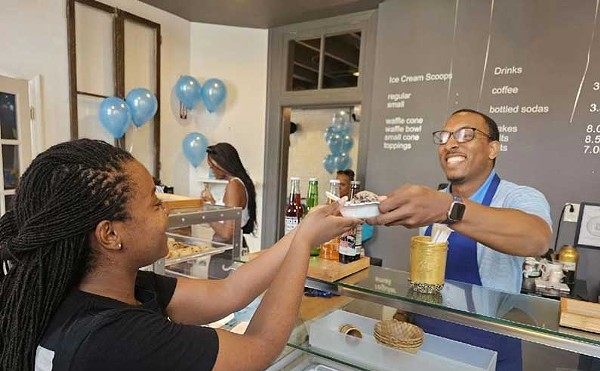My memory for details is sometimes suspect, so I dug through some old files and pulled out a 1984 issue of St. Louis magazine. Sure enough, a restaurant called Shalimar -- then located in the 7300 block of Manchester Road in what was sometimes called the "Maplewood Loop" and in those days looked like a viable competitor to its University City counterpart as an up-and-coming hip destination -- was described as "the oldest Indian restaurant in St. Louis." For some time, it was also pretty much the only Indian restaurant in St. Louis, perhaps best known for a 10-course masala-rama called the Royal Feast and lesser known as one of the few restaurants in town that wasn't air-conditioned.
Flash forward about 15 years, and Delhi food is almost as universal as deli food, found everywhere from downtown to Bridgeton to Chesterfield. The latest in the mix is Mirchea, open for about four months in a space formerly occupied by a Chinese restaurant in the same strip mall that drew lots of the adventurous-dining crowd to Choi's, one of the few places in town where one could find Filipino food. (We were sad to discover that Choi's -- which began life on Meramec Street in South St. Louis as the first Korean restaurant in town -- had recently closed. Signs announcing the impending opening of a Mexican restaurant called Chihuahua are now displayed in the papered-over windows.)
With the expanded number of choices, and, on the basis of our visits, I'd put Mirchea into the "10-minute" category -- if you live within a 10-minute drive or happen to be in the neighborhood, it's a fine choice, but it's not special enough to go driving all over town to try it out.
As with most Subcontinental places, one of the best appetizers is simply walking in the front door; your nostrils are instantly intoxicated by the scents of exotic spices. The on-menu appetizers parallel lots of other Indian menus, with pakoras, samosas and a few other items, and the entrées are also broken into familiar categories: chicken, lamb, seafood and vegetarian (including more than a dozen vegetarian choices), a tandoori list and a rice-dish list.
Our favorite of the sampled appetizers was the papdi chat, sort of an Indian potato salad, which featured chunks of potato and chickpeas mixed with thin crackers for texture and blended into a yogurt sauce. Our least favorite was the paneer pakora, an Indian cheese similar to cottage cheese battered with chickpea flour and deep-fried. In our case it more closely resembled a sacred stone than an airy touch of heaven, both in the crispy-almost-to-the-point-of-solid crust and the gray-hued cheese inside. Luckily, the petrifaction of the pakoras was not endemic; a collection of eggplant, zucchini and potato whimsically titled "Three Aces" had delicate, subtly nutty coatings and soft but firm interiors.
Of course, you can always spend significant time on the bread at an Indian restaurant, and we virtually swooned at the garlic nan, with smoky, dark-seared spots on the crust serving as collection points for roasted-on minced garlic. Nan and several other breads are available for a nominal charge, and every meal comes with complimentary papdum, nutty, spicy lentil crackers served with small metal bowls of mint and tamarind chutneys.
Mirchea means "pepper," and hot-and-spicy (although not blindingly so) was a recurring theme in many of the dishes. The hottest was lamb vindaloo, cubes of lamb and potato in a sauce with both aromatic spices and the lingering heat of chile pepper. Shrimp tikka masala was milder but still potent, six shelled medium-large shrimp seared in a tandoor oven and served in a vivid orange-pink tomato-cream sauce.
And reinforcing the notion that our paneer pakora was an anomaly, the saag paneer -- herbed creamed spinach with cubes of the same cheese -- featured dense but quite tender chunks, a textural counterpoint to the smoothness of the spinach.
Among the rice dishes, we opted for Mirchea's special biryani, which most closely resembled the special fried rice served at any number of Chinese fast-food places, although many planes higher. It's a combination of pretty much every main ingredient on the menu -- lamb, chicken, shrimp and vegetables -- buried under a dome of saffron-tinged basmati rice and slivered almonds, making an adventure of discovering all the hidden treasures.
With more than 40 entrées to choose from, we missed a couple of sections of the menu, but judging from the sizzling platter and profound onion aroma that filled the room when an adjoining table was served, we'd probably test out the tandoori dishes on a return visit.
Desserts include ice creams with nuts or mangoes, a mango custard, kheer rice pudding and the syruped round cakes called gulab jamun, but with fairly large portions fortified by mountains of rice, we could manage only one on either of our visits: ras malai, a couple of tiny islands of softened cheese floating in a rich condensed milk sweetened with rosewater and flavored with pistachios.
Service was exceptionally accommodating, even to the point of servers' almost begging us to take additional portions of rice with our entrées and then bringing one out unsolicited to take home with our carry-out order. We did, however, encounter a minor, recurring language barrier with one of our servers.
Given that Mirchea is within a 10-minute drive of my house, though, I'm really glad to have it in the neighborhood.





